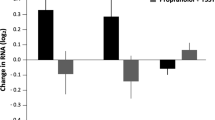Abstract
This study tested the general hypothesis that high- and low-hostile respondents would show different patterns of change in monocyte cytokine and adhesion protein (MCAP) expression in response to pharmacologically induced alterations in sympathetic nervous system (SNS) and parasympathetic nervous system (PNS) balance. On 3 separate days, 4 high- and 4 low-hostile respondents received isoproterenol infusions after saline, atropine (PNS blockade), or neostigmine (PNS stimulation) pretrcatment. Dual color flow cytometry with fluorescently labeled monoclonal antibodies to CD 14 (monocyte marker), interleukin-I, leukocyte function activator (LFA-1), Class II major histocompatibility complex (MHC-II), and tumor necrosis factor was used to quantify cytokine and adhesion protein expression on monocytes in blood samples drawn before and after the combination drug infusions on the 3 test days in each respondent. Following PNS stimulation and isoproterenol infusion there was a decrease (compared to saline pretreatment) in MHC II expression in high hostiles that was significantly (p > .02) different from an increase in low hostiles. A similar trend (p = .08) was seen for LFA-1 expression, with high hostiles showing an increase and low hostiles a decrease. These findings support the broad hypothesis that high-and tow-hostile respondents will show different MCAP responses 10 pharmacologically induced alterations in SNS-PNS balance. Such differences could contribute to accelerated atherogenesis among high-hostile individuals.
Similar content being viewed by others
References
Adams, D. O. (1994) Molecular biology of macrophage activation: A pathway whereby psychosocial factors can potentially affect health. Psychosomatic Medicine, 56, 316–327.
Cook, W. W., & Medley, D. M. (1954). Proposed hostility and pharasaic-virtue scales for the MMPI. Journal of Applied Psychology, 38, 414–418.
Fukudo, S., Lane, J. D., Anderson, N. B., Kuhn, C M., Schanberg, S.M., McCown, N., Muranaka, M., Suzuki, J., & Williams, R. B. (1992). Accentuated vagal antagonism of beta adrenergic effects on ventricular repolarization: Differential responses between Type A anti Type B men. Circulation. 85, 2045–2053.
Hartzell, H. C., & Fischmeisler, R. (1986). Opposite effeets of cyclic GMP and cyclic AMP on Ca2+ currenl in single heart cells. Nature. 323, 273–275
Muranaka, M., Monou, H. Suzuki, J., Lane, J. D., Anderson, N. B., Kuhn, C. M., Schanberg, S. M., McCown, N.,& Williams, R. B. (1988). Physiological responses to catecholamine infusions in Type A and Type B men. Health Psychology, 7(Suppl.). 145–163.
Miller, T. Q., Smith, T. W., Turner, C. W., Guijarrn, M. L., & Hallet, A. J. (1996). A meta-analytic review of research on hostility and physical health. Psychological Bulletin, 119, 322–348.
Ross, R.(1993). The pathogenesis of atherosclerosis: A perspective for the 1990s. Nature, 362, 801–805.
Sasaki, M., Lewis, J. G., Williams, R. B., Adams, D. O., & Suarez, E. C. (1996, April). Smoking and hostility alter molecular indices of monoctye activation in young men, Paper presented at the annual meeting of the Society of Behavioral Medicine, Washington. DC.
Seherwitz, K. W., Perkins, L. L., Chesney, M. A., Hughes, G. H., Sidney, S., &Manolio, T. A. (1992). Hostility and health behaviors in young adults: The CARDIA study. American Journal of Epidemiology, 136, 136–145.
Siegler, I. C., Peterson, B. L., Barefoot, J. C.,&Williams, R. B. (1992), Hostility in late adolescence predicts coronary risk factors at mid-life. American Journal of Epidemiology. 136, 146–156.
Sloan, R. P., Shapiro, P. A., Bagiella, E.,& Bigger, T. E. (1994), Cardiovascular autonomic control and hostility in healthy subjects. American Journal of Cardiology, 74, 298–300.
Smith, T. W. (1992). Hostility and health: Current status of a psychosomatic hypothesis. Health Psychology. 11, 139–150.
Smith, T. W., & Allred, K. D. (1989). Blood pressure reactivity during social interaction in high and low cynical hostile men. Journal of Behavioral Medicine, 11, 135–143.
Suarez, E. C., Sasaki, M., Lewis, J. G., Williams, R. B., & Adams, D. O. (1996) Anger increases expression of interleukin-l on monocytes in hostile women. Psychosomatic Medicine, 58, 87
Suarez, E. C., Shiller, A. M., Kuhn, C. M., Schanberg, S. M., & Williams, R. B., (in press). Hostility is associated with lymphocyte beta-2 adrenergic receplor/adenylate cyclase activity. Psychosomatic Medicine.
Suarez, E. C., & Williams, R. B. (1989), Situational determinants of cardiovascular and emotional reactivity in high and low hostile men. Psychosomatic Medicine. 51, 404–418.
Suarez, E. C., Williams, R. B., Harlan, E. S., Peoples, M. C., Kuhn, C. M., & Schanherg, S. M. (1991, October). Hostility-related differences in urinary excretion rates of catecholamines. Paper presented at the annual meeting of the Society for Psychophysiological Research. Chicago.
Thai, S.-F., Lewis, J. G., Williams, R. B., Johnson, S. P., & Adams, D. O. (1995). Effects of oxidized LDL on mononuclear phagocytes: Inhibition of induction of four inflammatory cytokine gene RNAs, release of NO, and cytolysis of tumor cells. Journal of Leukocyte Biology. 57, 427–433.
Williams, R. B. (1994). Neurobiology, cellular and molecular biology, and psychosomatic medicine. Psvchosomatic Medicine. 56, 308–315.
Author information
Authors and Affiliations
Additional information
This research was supported by giants from the National Heart, Lung and Blood Institute (P01-HL36587, R01-HL44998): the National Institute of Mental Health (K05-MH70482); the National Institute on Aging (5P60-AGII268. PO-AGI 2058); National Center for Research Resources. General Clinical Research Centers Program (M0l-RR-30), National Institutes of Health; and the Fetzer Institute.
This article is dedicated to the memory of Dolph O. Adams, who died on August 9, 1996.
Rights and permissions
About this article
Cite this article
Williams, R.B., Sasaki, M., Lewis, J.G. et al. Differential responsivity of monocyte cytokine and adhesion proteins in high- and low-hostile humans. Int. J. Behav. Med. 4, 264–272 (1997). https://doi.org/10.1207/s15327558ijbm0403_5
Issue Date:
DOI: https://doi.org/10.1207/s15327558ijbm0403_5




